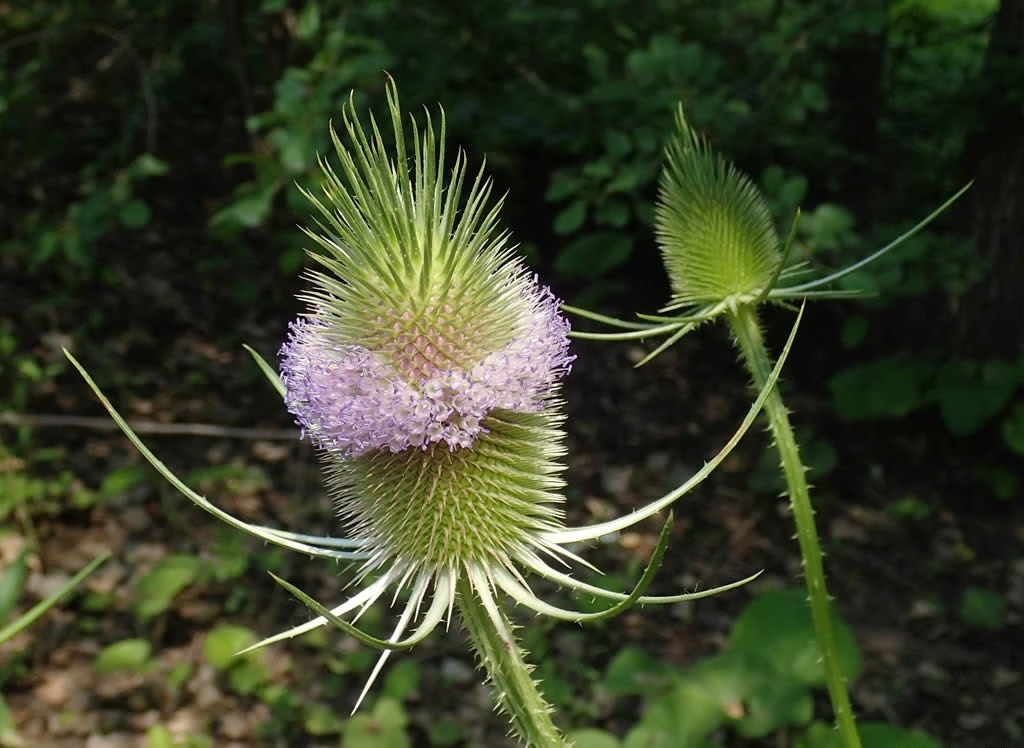
Teasels
Botanical Name
:
Dipsacus fullonum (Common Teasel)
Plant Type
:
Biennial
Seasons
:
Summer to early fall (blooms in the second year)
Sun Level
:
6–8 hours of full sun daily
Ideal Soil Temperature for Planting
:
60–70°F (15–21°C)
Soil Type
:
Well-draining, moist soil. It can grow well in various soil types including clay, loam, or sand but does not like wet poorly drained soils
Germination
:
14–21 days at 60–70°F (15–21°C)
P.H. Level
:
Neutral to slightly alkaline (6.5–7.5)
Water/Irrigation
:
Keep soil consistently moist but not waterlogged; drought-tolerant once established
Fertilization
:
Minimal fertilization; thrives in poor to moderately fertile soil
Habit
:
Tall, upright, with prickly stems and leaves. Forms a rosette in the first year, then a tall flowering stalk in the second year.
Final Plant Height
:
29–84 inches (76–210 cm)
Spread
:
12–24 inches (30–-60 cm)
Spacing
:
12–24 inches apart (30–60 cm)
Flowers
:
Small, clustered flowers in shades of purple, pink, or white, which bloom in a ring around the cone-shaped flower head.
Attracts
:
Bees, butterflies, and other pollinators. The seed heads attract birds in the winter.
Uses
:
Wildflower gardens, naturalized areas, dried flower arrangements, and wildlife gardens
Companions
:
Grasses, Goldenrod, and other wildflowers
Pruning
:
No pruning required except removing spent blooms occasionally for more flowering throughout the season
Toxicity
:
Non-toxic to humans and pets
Pests
:
Generally pest-resistant, occasional aphids
Diseases
:
Generally disease-resistant, avoid overwatering to prevent root rot
Fun Fact
:
Teasels were historically used in the textile industry to raise the nap on fabrics, a process known as “teasing.”
Botanical Name
:
Dipsacus fullonum (Common Teasel)
Plant Type
:
Biennial
Seasons
:
Summer to early fall (blooms in the second year)
Sun Level
:
6–8 hours of full sun daily
Ideal Soil Temperature for Planting
:
60–70°F (15–21°C)
Soil Type
:
Well-draining, moist soil. It can grow well in various soil types including clay, loam, or sand but does not like wet poorly drained soils
Germination
:
14–21 days at 60–70°F (15–21°C)
P.H. Level
:
Neutral to slightly alkaline (6.5–7.5)
Water/Irrigation
:
Keep soil consistently moist but not waterlogged; drought-tolerant once established
Fertilization
:
Minimal fertilization; thrives in poor to moderately fertile soil
Habit
:
Tall, upright, with prickly stems and leaves. Forms a rosette in the first year, then a tall flowering stalk in the second year.
Final Plant Height
:
29–84 inches (76–210 cm)
Spread
:
12–24 inches (30–-60 cm)
Spacing
:
12–24 inches apart (30–60 cm)
Flowers
:
Small, clustered flowers in shades of purple, pink, or white, which bloom in a ring around the cone-shaped flower head.
Attracts
:
Bees, butterflies, and other pollinators. The seed heads attract birds in the winter.
Uses
:
Wildflower gardens, naturalized areas, dried flower arrangements, and wildlife gardens
Companions
:
Grasses, Goldenrod, and other wildflowers
Pruning
:
No pruning required except removing spent blooms occasionally for more flowering throughout the season
Toxicity
:
Non-toxic to humans and pets
Pests
:
Generally pest-resistant, occasional aphids
Diseases
:
Generally disease-resistant, avoid overwatering to prevent root rot
Fun Fact
:
Teasels were historically used in the textile industry to raise the nap on fabrics, a process known as “teasing.”

